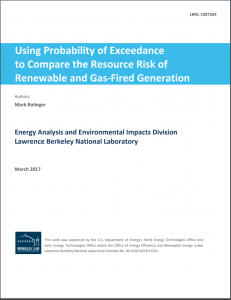Full Title: Using Probability of Exceedance to Compare the Resource Risk of Renewable and Gas-Fired Generation
Author(s): Mark Bolinger
Publisher(s): Lawrence Berkeley National Laboratory
Publication Date: March 1, 2017
Full Text: Download Resource
Description (excerpt):
Of the myriad risks surrounding long-term investments in power plants, resource risk is one of the most
difficult to mitigate, and is also perhaps the risk that most-clearly distinguishes renewable generation
from natural gas-fired generation. For renewable generators like wind and solar projects, resource risk
manifests as a quantity risk—i.e., the risk that the quantity of wind and insolation will be less than
expected. For gas-fired generators (i.e., a combined-cycle gas turbine or “CCGT”), resource risk
manifests primarily as a price risk—i.e., the risk that natural gas will cost more than expected. Most
often, resource risk—and natural gas price risk in particular—falls disproportionately on utility
ratepayers, who are typically not well-equipped to manage this risk. As such, it is incumbent upon
utilities, regulators, and policymakers to ensure that resource risk is taken into consideration when
making or approving resource decisions, or enacting policies that influence the development of the
electricity sector more broadly.
This paper presents a new framework, grounded in statistical concepts related to probability of
exceedance (and confidence intervals more broadly), to incorporate resource risk into decision-making
processes. This framework recognizes that the same probability of exceedance concepts that are
regularly used to characterize the uncertainty around annual energy production for wind and solar
projects can also be applied to natural gas price projections, allowing one to develop a probabilistic
range of projections for not only wind and solar capacity factors, but also natural gas prices.
Importantly, these probability distributions have markedly divergent characteristics. Renewable
resource risk is symmetrical about the mean or “P50” projection and declines when considered over
longer time horizons (due to mean reversion in the inter-annual variability of the resource). In contrast,
natural gas price risk is asymmetrical (skewed towards higher prices) and increases when considered
over longer time horizons (reflecting the fact that it is easier to project where natural gas prices will be
three months from now than three years from now). Converting these distinctly different probability
distributions into directly comparable levelized cost of energy (“LCOE”) terms reveals that even when
gas-fired generation is competitive with, or cheaper than, wind and solar power on an expected or P50
basis—the basis on which these resources are most often compared—comparisons that are instead
based on worse-than-expected outcomes (e.g., P25 or P1) often reach the opposite conclusion: that
wind and solar are cheaper than gas-fired generation.
